
Text by MARTIN WINDROW, Color plates by MICHAEL ROFFE. YEAR 1972
THE PANZER DIVISIONS
F2 Unterojffizier, Panzergrenadier, summer 1943
The relatively tidy soldier of 1940 has turned into an alert, scruffy, highly skilled veteran in three years of harsh warfare. His helmet is unchanged, except that it is worn comfortably pushed back, and the decals have long since worn off. The tunic and trousers are now of light reed-green cotton denim for summer comfort, and are worn with the sleeves rolled up and the chest unbuttoned, to taste. This sergeant, leading a patrol in Russia or Italy, has knotted an old civilian scarf round his throat as a sweat-rag. His insignia of rank are still worn at collar and shoulder. The ribbon of his Iron Cross 2nd Class is worn in the usual buttonhole, even in the front line; likewise his Sturmabzeichen, identifying him as a seasoned combat infantryman, is pinned to his tunic. On his left upper arm is a campaign shield; these were awarded for service in notably hazardous or successful actions - Kholm, Demjansk, Krim, the Kuban, all led to such awards. As a squad leader he carries field-glasses; on his belt are slung the canted webbing magazine pouches for his MP. 40 Schmeisser sub-machine gun, and he carries a stick-grenade ready in his hand. His main equipment has been left behind in his dug-out; on the back of his belt he would carry only his bread bag, mess tin, one or two canteens and perhaps a home-made canvas haversack of grenades or extra ammunition.
F3 Leutnant, Panzergrenadier Regt. 'Grossdeutschland', 1944
By 1944 camouflage clothing was being worn more and more frequently. This young armoured infantry officer bandaging a minor wound is a member of the elite Panzer Division 'Grossdeutschland'; he wears the unit's name on a silver-on- black cuff-title on his right sleeve, and a gilt 'GD' monogram on his shoulder-straps. His camouflaged helmet cover is in the usual splinter pattern of brown, dark green and light green, with a 'falling rain' pattern of dark green over the other shades. The loops are for extra camouflage in the form of foliage. His camouflaged twill tunic is identical with the usual field-grey officer's service tunic in cut, apart from lacking the deep turn back cuffs and pocket pleats. He wears his normal collar-patches and shoulder-straps on this combat garment, although a simple rank patch on the arm would be more in keeping with the spirit and letter of regulations. A map case is slung on his field service belt. The camouflaged over-trousers, with the distinctive break in pattern caused by the vertical seams, are gathered at the ankle over laced boots.
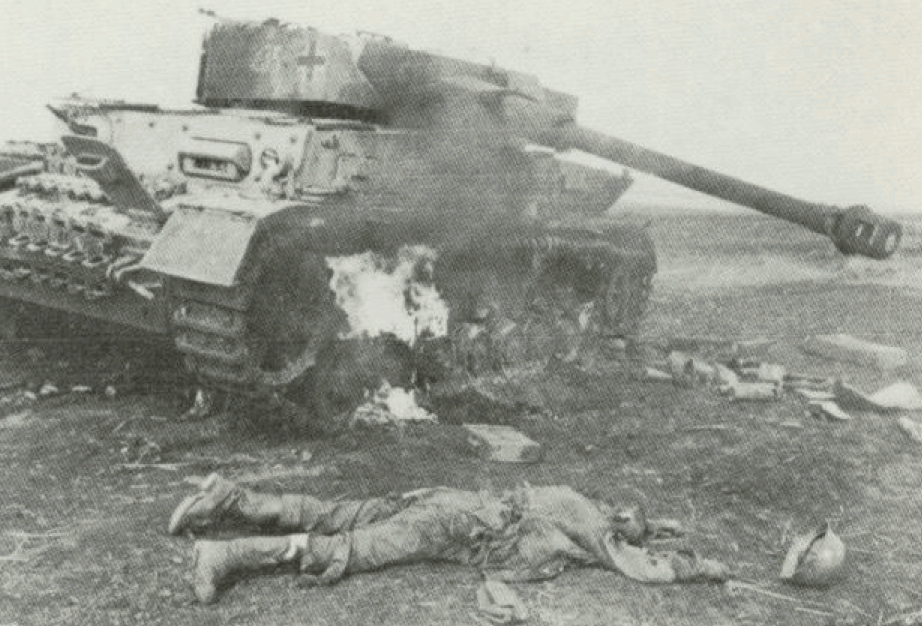
Despite their image of massive strength, the Panzers were no less vulnerable to the appropriate weapons than the tanks of any other army; this late-model PzKpfw. IV, with extra turret armour, was knocked out in Russia. (Imperial War Museum)
Camouflage clothing was not general issue to all German troops, but a variety of smocks, jackets, trousers and ponchos were available. A constant battle seems to have been waged by the higher command to limit the wearing of insignia on these garments to stylized arm rank patches; from the available photographic evidence, the front-line soldier's liking for his full unit and rank insignia won every time!
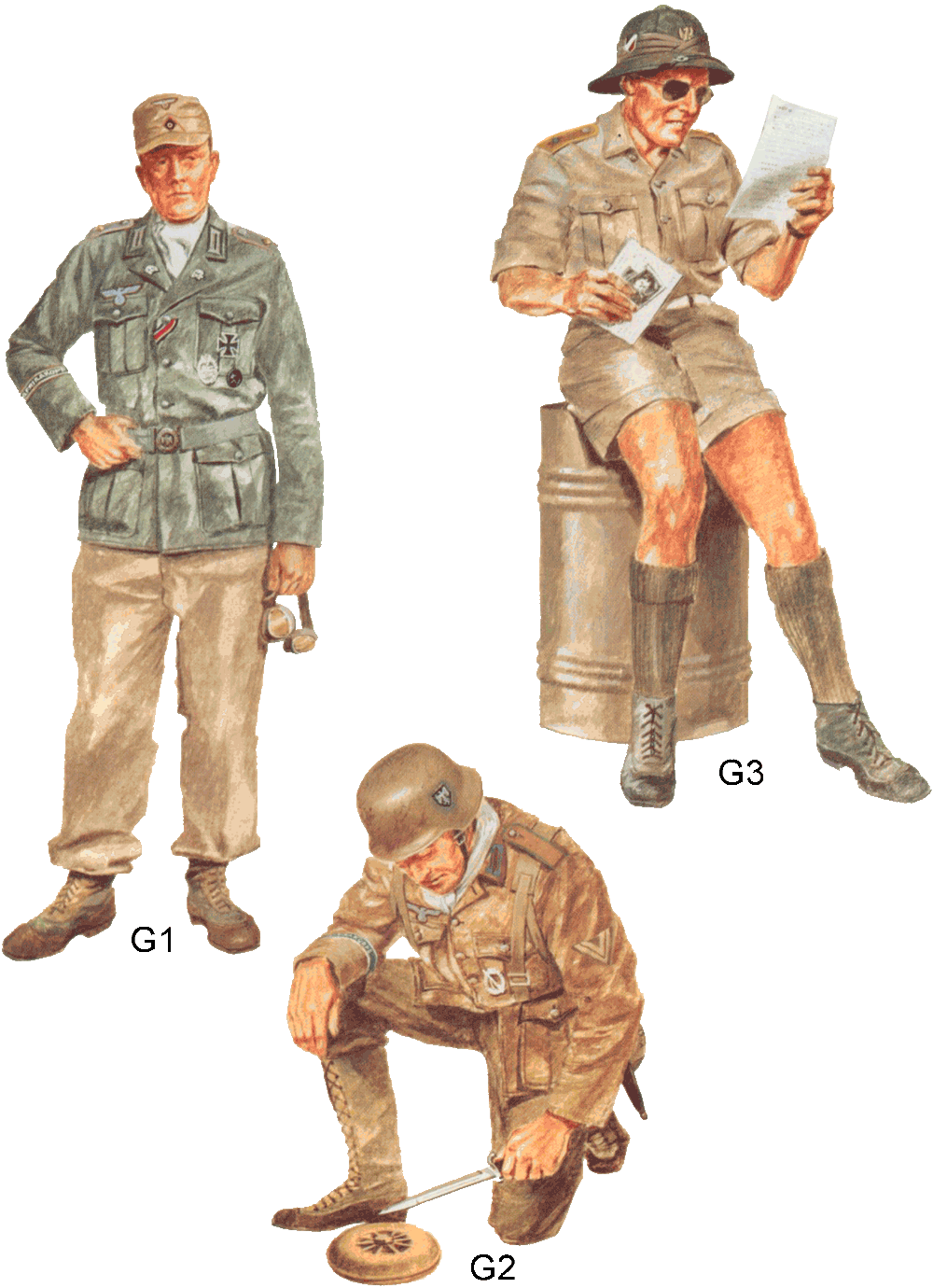
G1 Oberleutnant, Panzertruppen, D.A.K., 1942
This tank company commander of the Deutsches Afrika Korps wears one of many variations of uniform seen in the desert fighting - a campaign which seemed to encourage an individual approach to military dress by all ranks of all armies! This is a relatively smart version. The light, comfortable and stylish desert field cap, forerunner and direct ancestor of the 1943 Einheitsfeldmütze, was extremely popular and almost universally worn as the preferred dress. The national emblem was woven in blue-grey thread on a dull brown background, and the cockade on a diamond- shaped patch of brown. Officers usually wore caps with dull silver piping round the crown seam - and sometimes following the edge of the false 'turn-up' as well — but it was by no means uncommon for officers to wear 'Other Ranks' caps. The soutache of Waffenfarbe piping followed the upper edges of the diamond-shaped patch; here, in Panzer pink.
Open-necked shirts were the normal dress, but scarves were worn at personal taste. The drill tunic of sage-green lightweight material follows the general lines of the field-grey officer's service tunic, though without the turn-back cuffs. The colour of all items of tropical dress varied sharply. Some batches were green, others a dark, almost 'mustard' shade of tan, still others a light sandy shade. All weathered and bleached in short order after arrival in the desert, and any one unit might contain uniforms of similar cut but of shades ranging through every gradation from deep tan to mid-green. The normal officer's collar-bars are worn here on the upper lapel; Panzer officers pinned directly to the lower lapel the small metal skull badges from the collar-patches of the black vehicle uniform. The breast-eagle is an 'Other Ranks' version, in pale blue-grey thread on brown. The Iron Cross 1st and 2nd Classes are displayed in the usual way; Tank Assault Badge and a black Wound Badge are also worn. The belt is a light webbing pattern, with a circular bronze buckle embossed with an oak wreath and an eagle and swastika motif. The long, loose cotton drill trousers are of a light sandy shade - this contrast with the tunic colour is not deliberate, but merely the result of different batches of clothing being issued to his unit at different times. He wears them gathered at the ankle over the long canvas and leather desert boots, as extra protection against flies and sand. He carries a pair of amber-tinted sun and sand goggles.
The 'AFRIKA KORPS' cuff-title was authorized in July 1941; among the unit insignia for all members of the D.A.K. rather than campaign insignia.
G2 Obergefreiter, Panzergrenadier, D.A.K., 1942
Poorly equipped with specialized mine-lifting equipment in a theatre of war in which the mine played an enormous part, the Afrika Korps soldier was forced to do it the hard way - probing by hand with a bayonet. This cool N.C.O. wears the standard 1935 helmet, painted over with a matt sand colour. His scarf is a personal addition. His tunic is exactly similar in cut to that of the officer in Plate G1, but displays one of the many colour variations observed in the desert. His long trousers are tucked into the high-lacing canvas and leather desert boots. Belt and harness are of webbing, with darkened metal fittings. Shoulder-straps are of the usual design, but the ground colour is a light sandy tan. The rank chevrons are woven in a sand-yellow shade on a greenish-khaki patch; this yellow colour replaced the silver Tresse in N.C.O.'s rank distinctions. The faded blue-grey and brown collar-patches are typical of the tropical pattern insignia, as is the breast eagle in the same colours. The water canteen for tropical use has a conical black plastic cup. The Infantry Assault Badge is pinned to the left breast.
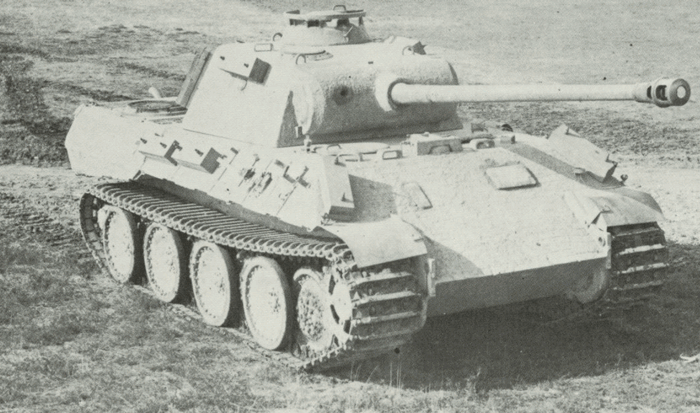
The magnificent 'Panther', PzKpfw. V. Introduced too hurriedly in an effort to counter the superb Russian T-34, the Panther suffered more casualties from technical failure than from enemy fire in the first months of service. The first batch of 300 were entirely 'used up' at Kursk in July 1943, many being destroyed by spontaneous engine fires. (Imperial War Museum)
G3 Wachtmeister, Aufklärungs Abteilung, D.A.K., 1941
The rank designations in cavalry units differed in some ways from those in the mass of the Army; Wachtmeister is the equivalent of Feldwebel, sergeant-major. It was the cavalry arm which, logically enough, provided most of the highly mobile reconnaissance units which were the eyes of the armoured divisions. The 33rd Reconnaissance Detachment, a unit of roughly battalion strength, served with the 15th Panzer Division from the earliest battles in North Africa.
It was drawn from Reiter Regiment 6, and was thus entitled to wear on all types of headgear the gold eagle tradition badge of the old Brandenburg Dragoons, the 'Schwedter Adler'. It was pinned between the two usual badges on the fronts of all caps, and to the front of the sun helmet issued when the unit took ship for Africa. This sun helmet, or Tropische Kopfbedeckung, was not a success, and was soon discarded in favour of the less cumbersome field cap - over which it had no j advantages from a protective point of view! The cloth pugaree illustrated here was not a common feature, but has been copied from a photograph of a soldier of this rank and this unit. The universal badges worn on the helmet were two shield-shaped metal plates with pin-backs, their design duplicating the insignia of the decals on the Army steel helmet.
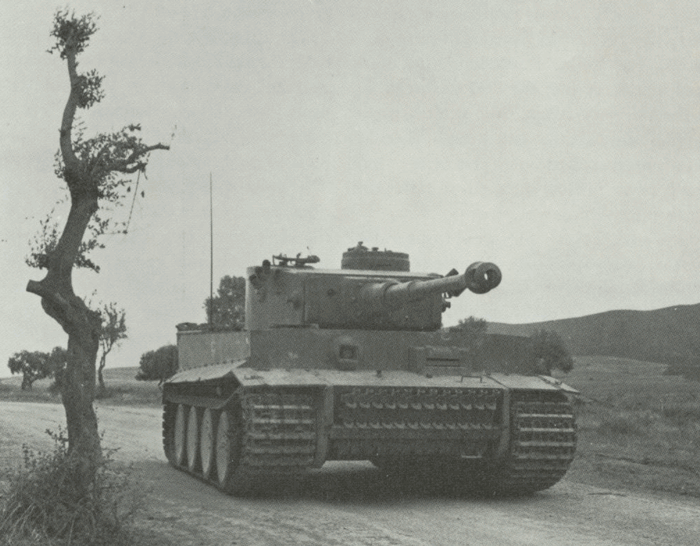
The name 'Tiger' became a symbol of terror to the crews of lighter Allied tanks. Despite its many drawbacks on the open battlefields of Russia, the PzKpfw. VI was so potent as a defensive weapon in the close countryside of north-west Europe that an image of crushing strength and invulnerability still clings to its name. (Imperial War Museum)
The shirt was very similar to the field-grey shirt worn in Europe, but as it was intended for frequent use on formal occasions in 'shirt-sleeve order' it was of superior finish and manufacture, with a reinforced yoke. The colour varied between a dark sandy shade and sage-green, and frequent washing soon faded it to an indeterminate tone. The shorts were frequently worn rolled up. The long woollen socks were often discarded in favour of ankle socks when in the field. The footwear illustrated is a type of 'sneaker' very similar in appearance and manufacture to the foot of the long desert boot, and perhaps cut down from it.
The only insignia worn with shirt-sleeve order are the shoulder-straps, looped and buttoned on in the usual way. Note that the silver Tresse is replaced by a washed-out sandy-yellow braiding on a brown ground. The normal grey metal pips are applied, however; the outer piping is in cavalry yellow.
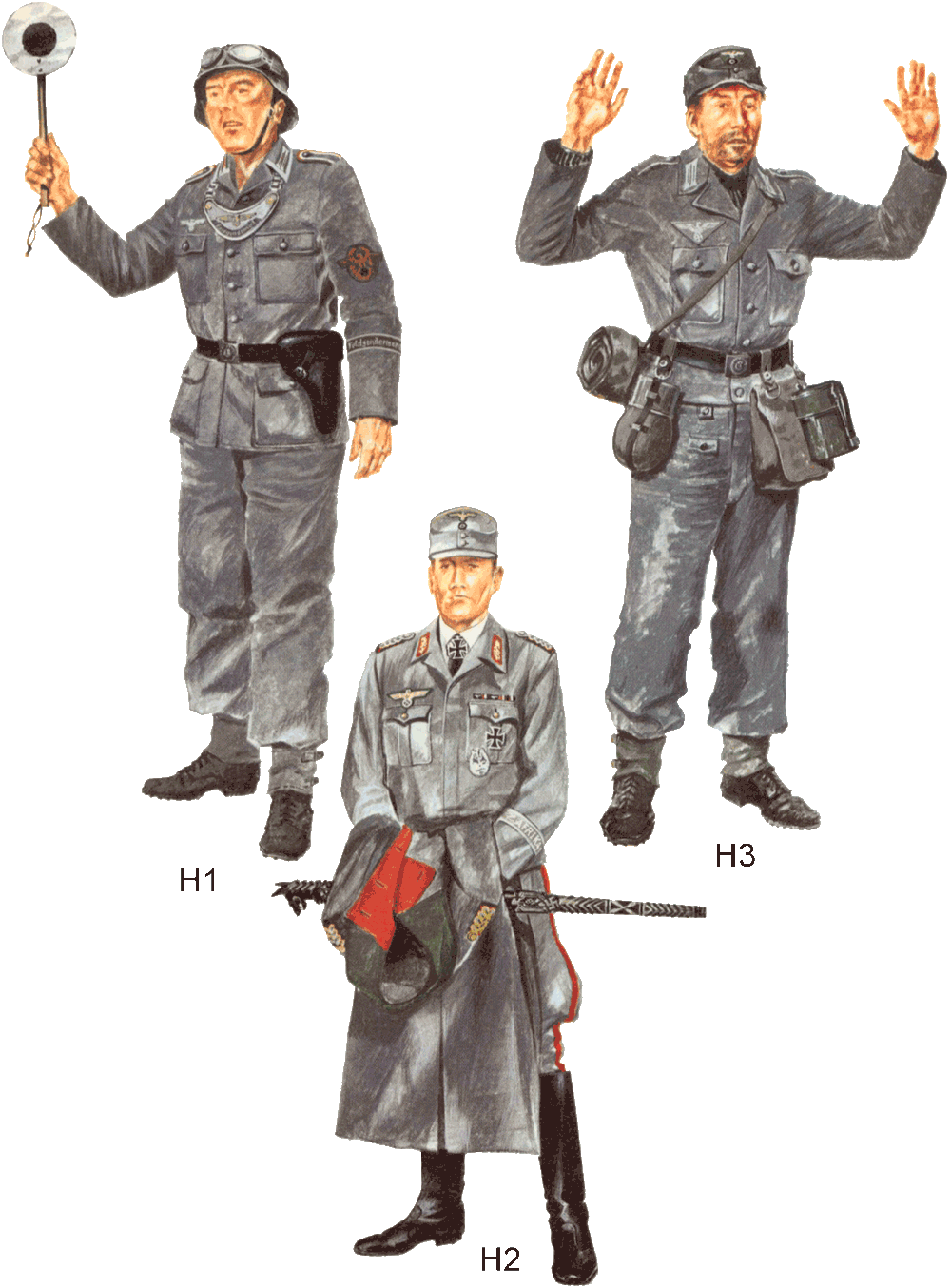
H1 Unterfeldwebel, Feldgendarmerie, summer 1944
An unappreciated but vital part of the armoured division - the divisional military police, responsible for keeping the thousands of vehicles moving on often poor and always crowded roads, sometimes under fire. Their other duties - disciplinary, and under front-line conditions harshly enforced - made them hated by the rank and file, but that would be inevitable in any army.
The Feldgendarmerie senior sergeant illustrated wears the service uniform commonly seen in 1944. The tunic is of 1943 pattern - similar in cut to the earlier style, but with various economy measures incorporated. The pockets have straight flaps, and are unpleated. The collar is no longer of dark green, but of field-grey like the rest of the tunic, and so are the shoulder-straps. The tunic is made from a poorer-quality cloth, with a high 'shoddy' content and an increased use of rayon rather than wool. It gave poor protection against heat and cold, and tore easily when wet.
The trousers are tucked into webbing anklets over laced ankle boots - another obvious economy measure in the hard-pressed Reich was the withdrawal of the high marching boot, which used up such vast quantities of leather.
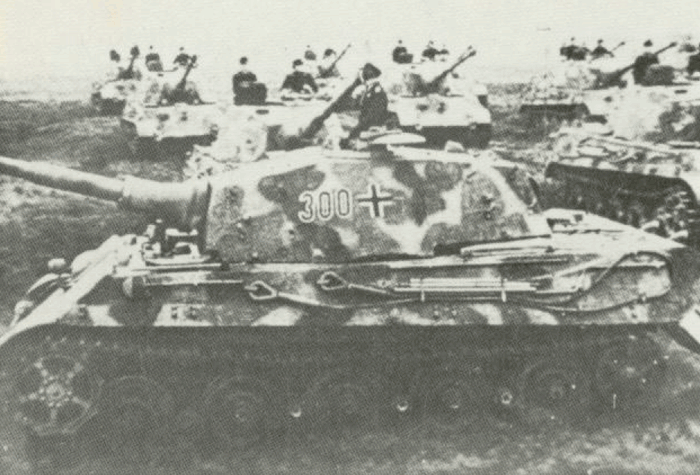
Company of 'Tiger II' ('King Tiger') heavy tanks on manoeuvres. The basic buff-yellow factory scheme was camouflaged at unit level with dark green and brown. These vehicles served in independent heavy tank battalions under direct Army command, rather than as integral units of the individual divisions. (Imperial War Museum)
Conventional insignia include the grey-on-sage-green breast-eagle, the silver Tresse round the collar, the collar-patches, and the shoulder-straps indicating rank, the latter piped in Feldgendarmerie orange Waffenfarbe. The special badge of this branch of service is sewn to the left upper arm - an eagle and swastika in a wreath, in the usual police style; the eagle and wreath are in Waffenfarbe orange, the swastika in black, and the patch is field-grey. Officers wore an identical badge in silver thread throughout. A cuff-title of brown cloth, edged with grey and bearing the word 'Feldgendarmerie' in grey Gothic script, is worn on the left forearm.
To indicate their function when on duty the military police wore the gorget or Ringkragen. This was of dull silver on a chain of masked links; two bosses and an eagle motif were picked out in yellowish luminous paint, as was the word 'Feldgendarmerie' on a grey scroll. It was this 'chain collar' which gave rise to one of the more printable soldiers' nicknames for the M.P.s — 'Kettenhund' ('Chained Dog').
H2 Generalmajor, Panzertruppen, field service dress, 1944
One of the young leaders who came to prominence as a result of direct battlefield experience in Africa and Russia, this Major-General wears the slightly more casual dress of the last few months of the war. The Schirmmütze was frequently replaced by the Einheitsmütze, even among General Officers; it is of superior material and finish, and has General's distinctions in the form of gilt buttons on the flap, gold piping round the crown, and a gold-on-dark- green woven badge.
The tunic is a high-quality modification of the troops' 1944 Feldbluse, the two-pocket waist-length garment introduced in place of the long-skirted tunic for economy reasons; cf. Plate H3. The more elaborate features of the General's pattern include pleated pockets with scooped flaps, and a fly front. The collar-patches of his rank are worn on the open collar, and the shoulder-straps are conventional; pocket and shoulder-buttons are gilt. He wears the national emblem above the right breastpocket, woven in gilt thread on a green background, and a row of campaign and service ribbons opposite. His Knight's Cross is visible at the throat, its ribbon passing under the shirt collar. On his left pocket are his Iron Cross 1st Class and a high grade of Panzer Sturmabzeichen; as the war progressed the tank arm began to see so much action that the 'three separate combats' qualification for this Assault Badge became meaningless. Versions with small plaques at the base were awarded for the appropriate number of actions - 25, 50, 75 and 100. The bronze version awarded to armoured car personnel appeared in the same variations.

The last throw - a 'King Tiger' passes a dejected column of American prisoners in the Ardennes, December 1944. (Imperial War Museum)
The red-striped breeches and jackboots are conventional. He carries over his arm the General's special pattern of greatcoat; this was of fine quality, field-grey in colour, with a dark-green collar, bright red lapel facings usually worn open and visible, and twelve large gilt buttons.
Two items mark specific areas of past service, one official and the other unofficial but characteristic. The 'Africa with Palms' cuff-title, worn on the left sleeve and bearing the word 'AFRIKA' between two palm heads, was instituted in January 1943 as a campaign decoration awarded to all ranks who completed six months' service in that theatre, or who were wounded. The script and edges are silver-grey, the band a soft brown. The carved stick is a souvenir much favoured by the Wehrmacht on the Eastern front - the famous 'Wolchowstock'. Carved with designs indicative of the unit's role and service, and with traditional Germanic decorations, it was sometimes presented to popular commanders when leaving a unit.
The sight which greeted the Tommies and G.I.s at the end - the last remnants of the Panzer Division trudging west to seek British or American captivity rather than Russian revenge.
Incredibly resilient for so long, the Wehrmacht had scraped the bottom of the barrel for manpower; boys, old men and medical rejects filled the ranks of the few veteran survivors. The distinction between a Panzergrenadier and an infantryman was now academic; the half-tracks had no fuel, and dared not move by day anyway. There was so much frantic, and pointless, redesignation of scratch units going on that the distinction was not even valid from an official point of view - hence this soldier's infantry white Waffenfarbe piping at the shoulders.
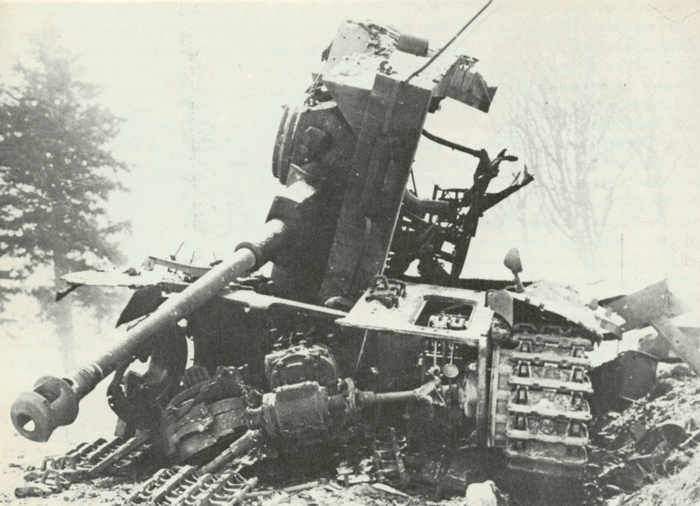
Brutally sculptured by flame and explosive, the gutted hulk of a late-model PzKpfw. IV in the Ardennes marks the graveyard of the last great Panzer assault wave. (Imperial War Museum)
He wears a poor-quality Einheitsmütze, and a wool-shoddy sweater under his Feldbluse. This economy garment carries a late-pattern national emblem above the right pocket, the eagle and swastika on a triangular patch. The collar-patches are also of a late, utility pattern - simple motifs in dull grey, without any branch or rank embellishments. (The silver collar-braid of senior N.C.O.s was seldom worn with the Feldbluse.)
He has abandoned all equipment not directly necessary to personal survival - assuming that he was ever issued with anything else. His bread bag, and a roll made from his weatherproof camouflaged shelter-quarter, contain his personal effects and what food he has managed to forage. His canteen and mess tin complete his simple needs. He will need nothing else in the P.O.W. cage.
We have much more interesting information on this site.
Click MENU to check it out!
∎ cartalana.com© 2009-2025 ∎ mailto: cartalana@cartalana.com